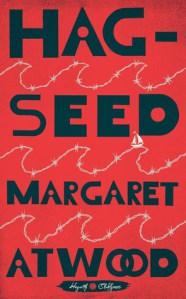 For some reason I started this book several times; it didn’t quite grab me at first. I suppose a story about a theater director seemed like it might be pretentious. I should have realized that Margaret Atwood wouldn’t write a pretentious book. Once I gave this book a couple of chapters, I was hooked. And by the end of it, I was in awe of the great Margaret Atwood’s skill and talent. She’s combined two things I love (Shakespeare and the power of education) into an entertaining and thoughtful story.
For some reason I started this book several times; it didn’t quite grab me at first. I suppose a story about a theater director seemed like it might be pretentious. I should have realized that Margaret Atwood wouldn’t write a pretentious book. Once I gave this book a couple of chapters, I was hooked. And by the end of it, I was in awe of the great Margaret Atwood’s skill and talent. She’s combined two things I love (Shakespeare and the power of education) into an entertaining and thoughtful story.
Hag-Seed is a re-telling of Shakespeare’s The Tempest. It’s part of the Hogarth Shakespeare project, a collection of modern-day books that re-imagine works of Shakespeare (others include Vinegar Girl by Anne Tyler and New Boy by Tracy Chevalier). Hag-Seed was nominated for the Bailey’s Women’s Prize for Fiction, but sadly it was not included in the shortlist (I haven’t yet read any of the shortlisted books, so can’t compare).
I was skeptical about this book because I’m not a huge fan of retellings of classics, because they tend to feel forced. An author retelling a classic has a set of plots and characters they have to include, which often don’t make much sense in a modern context. Certainly, there are some good ones: A Thousand Acres by Jane Smiley, The Story of Edgar Sawtelle by David Wroblewski, Bridget Jones Diary by Helen Fielding. But a retelling of The Tempest seemed a much more challenging task, with magic and fairies, enslavement, goddesses and goblins. Although it’s been done before, in the 1956 movie Forbidden Planet.
I’ve read and seen The Tempest a few times. Its themes of enslavement and exile make it one of Shakespeare’s more disturbing plays. But this book gave me a much greater appreciation for the complexity (and at times absurdity) of the story.
Felix Phillips is a theater director who is about to stage The Tempest when he is betrayed by his assistant and fired from his job. He recently lost his young daughter Miranda and he hasn’t recovered; understandably, it has affected his work. But without his work, he’s lost.
Atwood tells the story of The Tempest in a brilliant way: through the eyes of a group of low-security prison inmates who’ve signed up for a literature class taught by Felix. His class requires the students to stage a Shakespeare play from start to finish, and then he adds some writing assignments where students must reflect on 1) how the play can be adapted for its modern-day audience of inmates; and 2) what they think might happen to the characters after the play.
This set-up allows Atwood to explore complicated themes in The Tempest without it feeling forced. At the same time, there are clear parallels between the characters in the novel (Felix as Prospero, for example) and the characters in the play. In a way, she tells The Tempest’s story not just once, but twice. There are layers upon layers in this book.
When I started the novel, I thought it was going to be a “should read” but maybe not one I’d enjoy. I was surprised to find I raced through this novel in a couple of days, and enjoyed every minute.
Atwood’s book embraces an idea I feel strongly about: that all people, not just theater and literature snobs, can enjoy (and be shaped by) classic literature. Shakespeare wrote for the masses, after all. But it’s more than that. It’s also the idea that all people can rise to our expectations given the right kind of teaching. The correctional facility where Felix works didn’t believe the prisoners could understand Shakespeare. And yet everyone – teacher, students, and audience – grows from the experience.
You might be saying at this point that it sounds awfully feel-good, and not terribly realistic. It sounds like one of those hackneyed teacher-saves-downtrodden-students movies. I’ll admit, I’m a sucker for a good teaching story. But Atwood’s use of dialog and her clever layering of The Tempest‘s plot make the story feel realistic and new. For example, Felix tells his students that swearing will be forbidden in his class – UNLESS they are swearing in Shakespeare’s terms. The students are asked to go through the play and make a list of all Shakespeare’s insults. Then they can use those insults on each other freely — and they do. This is where the title “Hag-Seed” comes from. It’s an insult aimed at Caliban, who is the ill-begotten son of a witch, Sycorax. It’s an odd, even off-putting title for a book, but it makes perfect sense once you’ve read it.
There’s a rather odd emphasis on rape in some parts, and if this was a male writer I’d be bothered by it. I think it’s Atwood wrestling with that rather ugly part of the story, where Caliban’s revenge upon Prospero is the rape of his daughter. Miranda is played as passive, a prize to be won or taken by force.
In fact, this one of many areas where Atwood wrestles with the complexities and tensions of The Tempest. I absolutely loved the joy that Atwood brings to this telling of a dark and very strange story.

